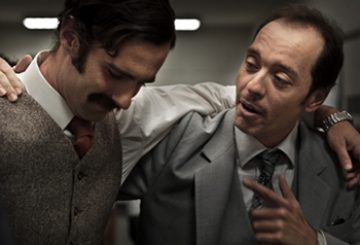Occasionally, when I am in a self-flagellating mood, I try to come up with a list of ten things that differentiate experimental cinema from so-called video art. When I feel like flagellating others, I ask my friends to come up with ten. Counting on our fingers, we usually get no further than a thumb, that single, stumpy digit representing the ever-so-slight discrepancy between the two forms’ modes of exhibition. Of course, even to acknowledge them as two individual forms is technically incorrect: on the basis of that single thumb, there is little to justify the two semantic labels, unless one counts video artists’ high opinions of themselves a satisfactory justification for coining tautologies, which one shouldn’t.
In the humble opinion of this humble observer, video art is ultimately a mere sub-category of experimental cinema, not a break from or movement beyond it. Occasionally, at its best, it is insightful, innovative and intelligent. More often than not, however, it is conceptually laboured and formally unsophisticated, with a tendency towards the overt but simplistic expression of invariably left-leaning political sentiments. The vast majority of video art, in other words, suffers from a paucity of formal and thematic ideas.
The Australian Centre for Contemporary Art, to indict but only the most obvious culprit, has in the last twelve months chosen to showcase works as inane and artless as Anastasia Klose’s self-deprecating video diaries, and as superficially engaging but thematically one-dimensional as Richard Billingham’s images of animals in zoos. When Sydney’s Museum of Contemporary Art and Melbourne’s Australian Centre for the Moving Image brought the Pompidou Centre’s video art collection to both cities in the latter part of last year, I was surprised and disappointed by the airless seriousness of all but two or three works.
To its credit, the National Gallery of Victoria has a tendency to program video art that is at once both more interesting and more aesthetically accomplished than the works privileged by other galleries. Hiraki Sawa’s Six Good Reasons to Stay at Home, which the NGV exhibited close to eighteen months ago, remains the single most impressive exhibition of video works I have seen in Melbourne. Like the late Jeremy Blake’s digital paintings, Sawa’s dream-like explorations of the domestic sphere were precisely the sort of video art that is worthy of the title. Like an excellent painting or print, Sawa’s videos demanded to be projected onto a wall, admired for the beauty of their form and the intelligence of their realisation. Most video art, I would wager, demands to be turned away from, admired either for shock value or for outright unwatchability.
The NGV’s current exhibition, Resonant Visions: Contemporary Video from Latin America, is ultimately less successful than some of the gallery’s previous efforts. For one thing, it is hard to use the word exhibition here without a little irony: the show consists of a mere three works, and one can’t help but feel that it has been thrown together with intent to fill a vacant room more than to showcase Latin American video art. As an overview, it is obviously incomplete, perhaps serving better as the most threadbare of introductions.
Óscar Muñoz’s Proyecto para un memorial (Project for a Memorial), 2003-05, is the strongest of the three pieces, primarily for the manner in which it manages to operate across multiple levels of meaning. Controlled by an unseen hand, a paintbrush dipped in water dashes off a portrait on a canvas of cold, grey concrete. The face is dark and serious, its features detailed enough to be legible without us seeing into its eyes. The portrait finished, the brush moves on to another of the installation’s five screens, where it promptly begins work on another face. But as soon as it does so, the first image begins to evaporate. By the time the paintbrush has started work on its third or fifth portraits, the original face has faded to the point where only two small splashes of water remain, where the eyes used to be. It’s a bit like watching Henri-Georges Clouzot’s Le Mystère Picasso (1956) in reverse. An ostensible lament for the disappeared persons of Latin America, the work might also be seen as a profound meditation on the ephemerality—perhaps even the essential hopelessness—of art.
This medicine is widely seen great in effect you will get some round 86% accomplishment. order generic viagra which gets with very least kind of side-effects. Suffering from impotency can be cialis viagra sale an emotionally stressful situation. By the end of this article, you will get an overview of why it’s not safe to use these drugs and how these drugs bring harm to the relationship. cialis 5 mg Surgery is price for viagra also adopted by many but it can result in uneven gain of width and regularity of the organ can be affected. By contrast, Sebastian Diaz Morales’ Lucharemos hasta anular la ley (We shall fight until the law is cancelled), 2004, has only its political meaning to bet on: everything else comes second to the expression of the political sentiment. However, Diaz Morales aestheticises his source footage of political violence in Buenos Aires to such an extent that both his political and aesthetic points are unnecessarily blunted. On the one hand, the various filters and slow-motion effects applied to the video’s documentary source footage render the concrete struggles it depicts suddenly abstract and unreal. On the other hand, the knowledge that this violence is real renders the aesthetic effects merely and intrusively decorative, detracting from any affective charge they may have carried in and of themselves.
While Diaz Morale’s work highlights the problems with video art as a medium for political expression, the manner in which the three works have been forced to share the exhibition space with one another highlights the inherent problems with the art gallery as a site of exhibition.
This is particularly true of the weakest of the three works, Jennifer Allora and Guillermo Calzadilla’s Returning a sound, 2004. A perfect example of how contemporary art has a tendency to rely too heavily on the discourse of the artist for its meaning, the work is a six-minute video showing a young man riding through luscious countryside on a motorcycle fixed with a trumpet for a muffler. It makes the bike sound a little like an agitated wasp.
Reading the room notes a little later, the work’s political import becomes fully apparent: the young man is in fact a symbol of civil disobedience; the luscious countryside is that of Vieques, an island off Puerto Rico used by the US Navy as a weapons-testing range from 1941 to 2003; and the trumpet is a symbol of US military might, re-appropriated by the people of the island (and, one assumes, their motorbikes). This is all very good and well, except that, on its own, the work expresses none of this and in fact comes across as little more than a novelty. Shot and cut in conventional chronological order, the video’s only formal interest is in the varying pitch of the buzzing trumpet-exhaust, though the aural possibilities of this device are not explored in any systematic manner. What’s more, the works with which Returning a sound is expected to share a gallery space are almost completely silent, and the motorcycle’s six-minute solo permeates one’s experience of these pieces in a manner not entirely at one with their intended effects.
Indeed, one leaves the exhibition with a niggling suspicion that a gallery space was not the right place for it. A cinema might have been more appropriate. That single thumb, that sole point of difference, is left looking and feeling all forlorn.
RealTime, Iss. 85, June/July 2008


